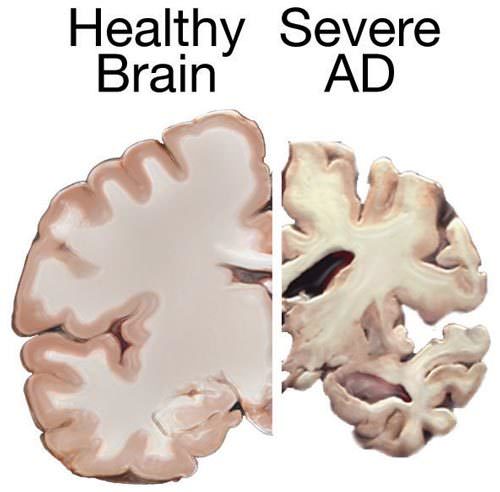案例研究:你身体的控制中心
章节大纲
-
Case Study: Fading Memory
::案例研究:消退记忆Each of these brightly-colored sticky notes represents a piece of information that someone doesn’t want to forget. Although we are all forgetful sometimes, most people do not have trouble remembering things that are important or routine to them , such as a friend’s name or how to get to class. Our brain — the control center of the nervous system and the rest of the body — normally allows us to retain and recall information. If, however, the brain is damaged, a person may need to rely excessively on external reminders — like this wall of sticky notes — rather than their own memory... if they can remember to write things down in the first place.
::这些亮彩色的粘贴笔记都是人们不想忘记的一件信息。 虽然我们有时都忘记了,但大多数人并不难记住对他们来说重要或例行的事情,比如朋友的名字或如何去上课。 我们的大脑 — — 神经系统的控制中心和身体的其余部分 — — 通常允许我们保留和回忆信息。 但是,如果大脑受损,一个人可能需要过度依赖外部提醒 — — 如这堵粘贴笔的墙 — — 而不是他们自己的记忆,如果他们能记住写下来的话。 大脑 — — 神经系统的控制中心以及身体的其余部分 — — 通常会允许我们保存和回忆信息。 但是,如果大脑受损,人们可能需要过度依赖外部提醒 — — 如这堵贴笔的墙 — — 而不是他们自己的记忆。One person having trouble with her memory is 68-year-old Rosa. Rosa has been struggling to remember where she has set down objects in her house, and she forgot about a few doctor’s appointments and lunches she planned with friends. Her family began to notice that she would sometimes fail to recall recent conversations, requiring them to repeat things to her. Rosa would also sometimes struggle to find the right word in a conversation, and would put objects in unusual places, such as the milk in a cabinet instead of the refrigerator. While most people do things like this occasionally, it seemed to Rosa and her family that it was happening to her more regularly .
::她的家人开始注意到她有时会忘记最近的对话,要求她们重复一些事情。 罗莎有时也会在谈话中为找到正确的词而挣扎,并且会把东西放在不寻常的地方,比如牛奶放在柜子里而不是冰箱里。 虽然大多数人偶尔会这样做,但罗莎和她的家人似乎都觉得这样的情况更经常发生。Rosa also had other symptoms that were impacting her life, such as having trouble paying her bills on time and managing her budget, which she had previously done well. She ascribed these lapses in memory and mental functioning to the normal effects of aging, but her family was concerned. They noticed that she was also more irritable than usual and would sometimes verbally lash out at them, which was not like her. When she became disoriented on a walk around her neighborhood and a neighbor had to escort her home, her family convinced her to see a doctor.
::Rosa还有影响她生活的其他症状,例如难以按时支付账单和管理预算,她以前做得很好。她将这些记忆和精神功能的缺失归因于老龄化的正常影响,但她的家人担心。她们注意到,她也比平常更暴躁,有时会辱骂她们,这不像她。当她走在邻居周围,邻居不得不陪她回家时,她的家人说服她去看医生。Besides a complete physical exam and lab tests, Rosa’s doctor interviewed Rosa and her family about her memory, ability to carry out daily tasks, and mood changes. He also administered a variety of tests to assess her memory and cognitive functioning, such as her ability to solve problems and use numbers and language correctly. Finally, he ordered a scan of her brain to investigate whether a tumor or some other observable cause was leading to changes in the functioning of her brain.
::除了完整的体格检查和实验室测试之外,罗莎的医生还就她的记忆力、执行日常任务的能力以及情绪变化等与罗莎及其家人进行了访谈。 他还进行了各种测试来评估她的记忆和认知功能,比如她解决问题、正确使用数字和语言的能力。 最后,他下令对她的大脑进行扫描,以调查肿瘤或其他可见的原因是否正在导致她的大脑功能的改变。Based on the results of these tests, Rosa’s doctor concluded that she most likely has mild Alzheimer’s disease (AD). AD results from abnormal changes in the molecules and cells of the brain, characterized by clumps of proteins (called amyloid plaques) between brain cells and tangled bundles of protein fibers (called neurofibrillary tangles) within certain brain cells. The affected brain cells stop functioning properly, lose their connections to other brain cells, and will eventually die. The picture below shows part of a cross-section of a brain from a patient who had severe AD, compared to a similar section of a healthy brain. You can see how severely shrunken the brain with AD is, due to the death of many brain cells.
::根据这些测试的结果,罗莎的医生得出结论,她最可能患有轻度阿尔茨海默氏病(AD ) 。 大脑分子和细胞的反常变化(AD ) , 其特征是脑细胞和某些脑细胞中缠绕的蛋白质纤维(Nealfibrillary tangles ) 之间的蛋白质(AMIS ) 块(AD ) 。 受到影响的脑细胞停止正常运转,失去与其他脑细胞的连接,最终会死亡。 下图显示患有严重ADD的病人脑部截面的一部分与健康大脑的类似部分相比。 你可以看到,由于许多脑细胞死亡,大脑被严重地用AD击破了大脑。AD is a progressive disease, which means the damage and associated symptoms get worse over time. Clinicians have categorized the progression into three main stages — mild, moderate, and severe AD. Typically, AD cannot be definitively diagnosed until after death, when the brain tissue can be directly examined for plaques and tangles. B ased on Rosa’s symptoms and the results of her tests, though, her doctor thinks she most likely has mild AD. At this stage, the brain changes, but resulting symptoms are not yet severe.
::AD是一种累进性疾病,这意味着损害和相关症状随着时间推移而恶化。 临床医生已经将进化分为三个主要阶段 — — 轻度、中度和重度AD。 通常,AD在死亡后才能被确诊,直到大脑组织可以直接检查斑块和纠结。 根据罗莎的症状和检测结果,她的医生认为她很可能患有温和AD。 在现阶段,大脑的变化,但由此产生的症状还不算严重。Although there is currently no cure for AD and Rosa will eventually get worse, her doctor says that medications and behavioral therapies may improve and prolong her functioning and quality of life over the next few years. He prescribes a medication that improves communication between brain cells, which has been shown to help some people with AD.
::尽管目前没有治疗AD的药方,而且Rosa最终会病情恶化,但她的医生说,在未来几年里,药物和行为疗法可以改善和延长她的功能和生活质量。 他开的药可以改善脑细胞之间的沟通,这证明可以帮助一些人使用AD。As you read this chapter, you will learn more about how the brain and the rest of the nervous system work, along with the multitude of functions they control in the body. By the end of the chapter, you will have enough knowledge about the nervous system to learn more about why AD causes the symptoms that it does, how Rosa’s medication works, and some promising new approaches that may help physicians diagnose and treat AD patients at earlier stages.
::当你阅读本章时,你会更多地了解大脑和神经系统其他部分是如何工作的,以及它们控制身体的多种功能。 到本章结尾,你将有足够的神经系统知识来了解为什么AD造成症状,罗莎的药物如何起作用,以及一些有望帮助医生在早期诊断和治疗AD病人的有希望的新方法。Chapter Overview: Nervous System
::章节概览:神经系统In this chapter you will learn about the human nervous system, which includes the brain, spinal cord, and nerves. Specifically you will learn about:
::在本章中,你将了解人类神经系统,包括大脑、脊髓和神经。具体来说,你将了解:-
The organization of the nervous system — including the central and peripheral nervous systems — and their organs and subdivisions
::神经系统的组织,包括中央和外围神经系统的组织及其器官和分区 -
The cells of the nervous system — neurons and glia — their parts, and their functions
::神经系统的细胞——神经元和吉利亚——其部分和功能 -
How messages are sent by neurons through the nervous system, and to and from the rest of the body
::神经元如何通过神经系统向身体其余部分传递神经元的信息 -
How these messages (or nerve impulses) are transmitted by electrical changes within neurons, and through chemical molecules to other cells
::这些信息(或神经脉冲)是如何通过神经元中的电子变化和通过化学分子传播到其他细胞的? -
The structure and functions of different parts of the central nervous system, which includes the brain and spinal cord, and some of the things that can go wrong when they are damaged
::中枢神经系统不同部分的结构和功能,包括大脑和脊髓,以及一些在受损时可能出错的东西。 -
The structure and functions of the peripheral nervous system, which includes the nerves that carry motor and sensory information to and from the body to control voluntary and involuntary activities
::外围神经系统的结构和功能,包括携带运动和感官信息的神经系统,以控制进出身体的自愿和非自愿活动。 -
The human senses, as well as how visual information, sounds, smells, tastes, touch, and balance are detected by sensory receptor cells and then sent to the brain for interpretation
::人类感官以及视觉信息、声音、气味、味道、触觉和平衡如何通过感官受体细胞检测到,然后送到大脑解释 -
How legal and illegal drugs can have psychoactive effects on the brain — altering mood, perceptions, thinking, and behavior — which can sometimes lead to addiction
::合法和非法药物如何能对大脑产生精神影响——改变情绪、观念、思想和行为——有时会导致吸毒成瘾。
As you read the chapter, think about the following questions:
::当你读到该章时,请考虑以下问题:1. Based on Rosa’s symptoms, which parts of her brain may have been affected by Alzheimer’s disease?
::1. 根据Rosa的症状,她的大脑中哪些部分可能受到阿尔茨海默氏病的影响?2. How are messages sent between cells in the nervous system? What molecules are involved in this process? In what ways can drugs alter this process?
::2. 神经系统细胞之间如何发送信息?这一过程涉及哪些分子?药物如何改变这一过程?3. Why can’t Rosa’s brain simply grow new cells to replace the ones that have died?
::为何罗莎的大脑不能简单地发展新的细胞来取代死去的细胞呢? -
The organization of the nervous system — including the central and peripheral nervous systems — and their organs and subdivisions

